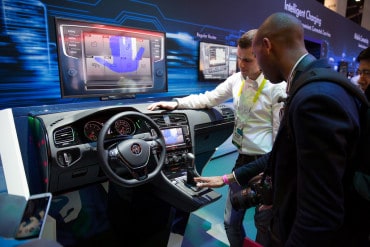
Thanks to advanced 3D rendering, AI, and immersive technologies such as AR and VR, we’re at a turning point when it comes to blurring the lines between the digital and physical worlds.
Digital experiences are constantly evolving and more closely resembling real life. From the evolution of black and white photos and film to color; or command-line interfaces on a computer program evolving to simply require the click of a button and voice commands; generations of technologists have strived to bring people and digital reality closer together. Today, that evolution has engulfed the world of augmented and virtual reality, powered by AI and 3D technology. This new technology provides a richer digital experience and breakthrough applications that were, just a short while ago, unimaginable.
Tapping the Potential of 3D in Different Industries
Today, 3D has very real consumer and industrial applications in virtual and augmented realities, and its use cases are only growing.
In the consumer marketplace, immersive experiences that leverage virtual and augmented reality (VR and AR) are enabling people to socialize, play games and even shop. Retailers are enabling consumers to try on clothing before they purchase it online using AR. Museums are using VR to create digital exhibitions, where famous paintings such as Monet’s Water Lily come to life in 3D. And today, home buyers can take a virtual tour of a property without ever leaving the comfort of their homes.
The potential of the much-talked-about metaverse remains vast, and digital twins that combine 3D imaging with accurate physics modeling enable the creation of complex simulations that are as close to real life as possible. These abilities, powered by 3D technology, support meaningful decision-making in key areas. AR is being used to assist with surgical procedures, allowing doctors to view and manipulate 3D models of a patient’s anatomy in real time. A digital twin of a grid in any city could be used to test solutions to minimize waste or to introduce new sources of wind and solar power. And AR and AI allow human pilots to simulate aerial combat to perfect their skills in a controlled environment. These are just some of the use cases for augmented and virtual reality powered by 3D.
See also: Why True 3D Visualizations Are Replacing 2D and Static 3D
3D Experiences Enabling A New Type of Digital Universe
To realize the vision of a digitally enhanced physical world, it is essential to build an ecosystem of advanced technologies and services. While consumer applications in entertainment and retail have driven much of the early adoption, industrial applications in healthcare, military, and manufacturing require a much higher level of accuracy. To support these applications, digital twins will evolve to be much more photorealistic and support physics-based simulations.
Artificial intelligence will also play a key role in generating 3D representations of real-world objects and locations, with advances in generative AI accelerating the creation of virtual 3D worlds. Developers are realizing the huge opportunities through breakthrough technologies, such as NVIDIA Omniverse, a platform for creating metaverse applications and 3D assets through simulation and generative AI capabilities. While this type of innovation is breaking new ground, human intervention is still necessary to validate the accuracy of realistic objects and 3D representations.
Cloud and edge computing, combined with low-latency hardware, are enabling the creation of wearables that provide immersive experiences. Collaborative development platforms will drive best practices and provide the right tools to generate 3D worlds, facilitating remote collaboration between geographically dispersed teams. Extended-reality technologies will continue to evolve, leveraging this ecosystem of technologies to drive innovation in immersive experiences, including AR, VR, and mixed reality.
Although adoption of the metaverse, AR, and VR technologies is still in its early stages, as these technologies become more accurate and the interaction between humans and machines becomes more seamless, we can expect widespread adoption. Already, applications such as simulated training, remote operations, and design validation are gaining traction in industries such as healthcare, manufacturing, and architecture. As these applications prove their value, we can expect other industries to follow suit. While the full potential of these technologies has yet to be realized, they will unlock new levels of creativity and innovation and create a better world for all. According to Capgemini, “Immersive technologies are going to touch every aspect of our lives. Bandwidth is increasing, content quality is improving, and computing power is getting cheaper and more ubiquitous. As we bring these innovative technologies closer to the public, we have an opportunity to create bigger, better experiences.”
Jeff Kember, Director of Omniverse Technologies for NVIDIA, sums it up nicely, “The metaverse is a 3D embodied Web, where we can connect inside virtual worlds that look and feel to us as rich and complex as the real world. We can play, socialize, work, and create within these interoperable worlds despite being separated by great distances in the real world.”
Thanks to advanced 3D rendering, AI, and immersive technologies such as AR and VR, we’re at a turning point when it comes to blurring the lines between the digital and physical worlds. This will enable better customer and consumer experiences, better employee experiences, and ultimately a better human experience.





























